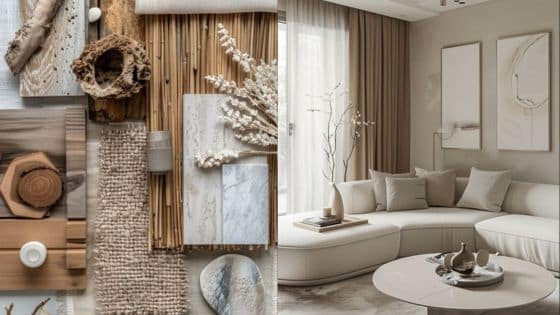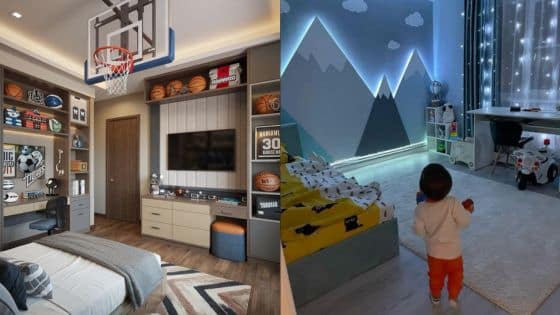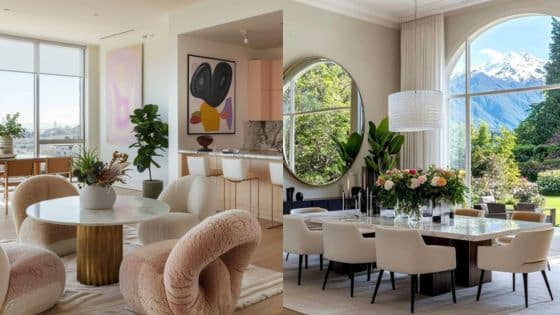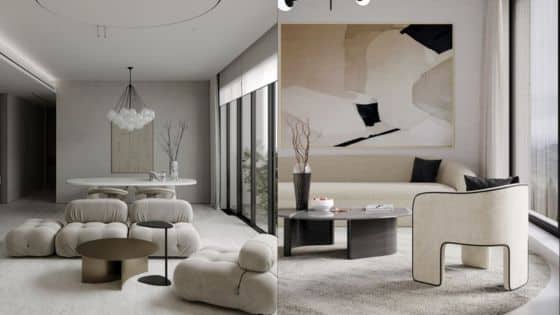Minimalist industrial design brings together the raw, rugged elements of industrial spaces with the clean simplicity of minimalist principles. This distinctive style emerged from repurposed factory spaces and lofts, celebrating exposed structural elements like concrete floors, metal beams, and ductwork while maintaining a clutter-free environment. By combining utilitarian materials with purposeful design choices, minimalist industrial spaces create environments that feel simultaneously authentic, functional, and visually striking without overwhelming the senses.
The appeal of minimalist industrial design lies in its ability to create harmony between seemingly opposite approaches. You’ll find the warmth of natural wood contrasting with cool metal finishes, or vintage factory fixtures paired with sleek modern furniture. This balance makes the style remarkably versatile, working equally well in urban apartments, suburban homes, and commercial spaces seeking to create an atmosphere of understated sophistication.
Key Takeaways
- Minimalist industrial design combines exposed structural elements with clean, uncluttered spaces to create functional environments with authentic character.
- The style relies on a thoughtful mix of raw materials like concrete, metal, and reclaimed wood balanced with strategic lighting and minimal decor.
- You can achieve this aesthetic through purposeful furniture choices, neutral color palettes, and by emphasizing the inherent beauty of structural elements rather than hiding them.
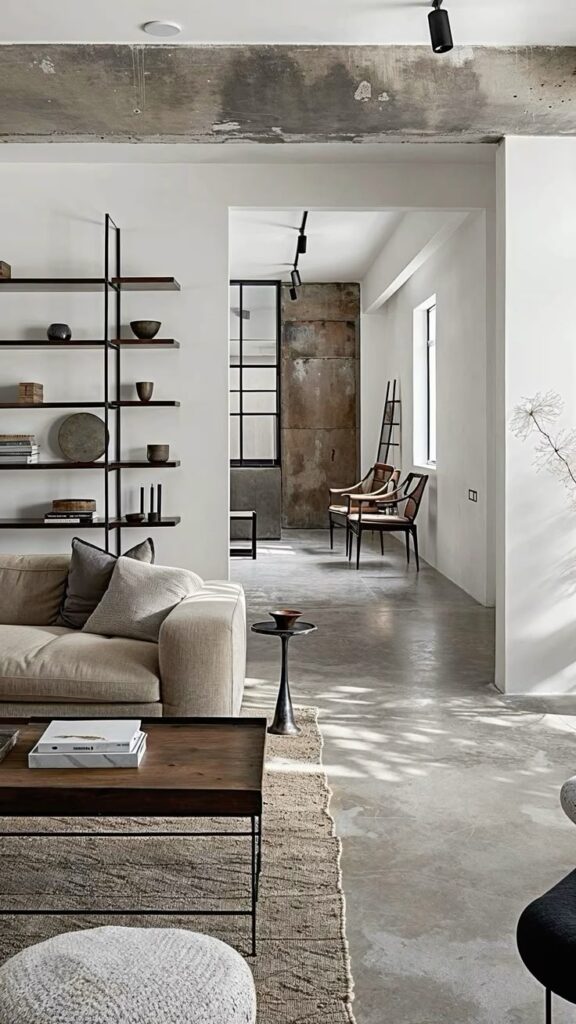
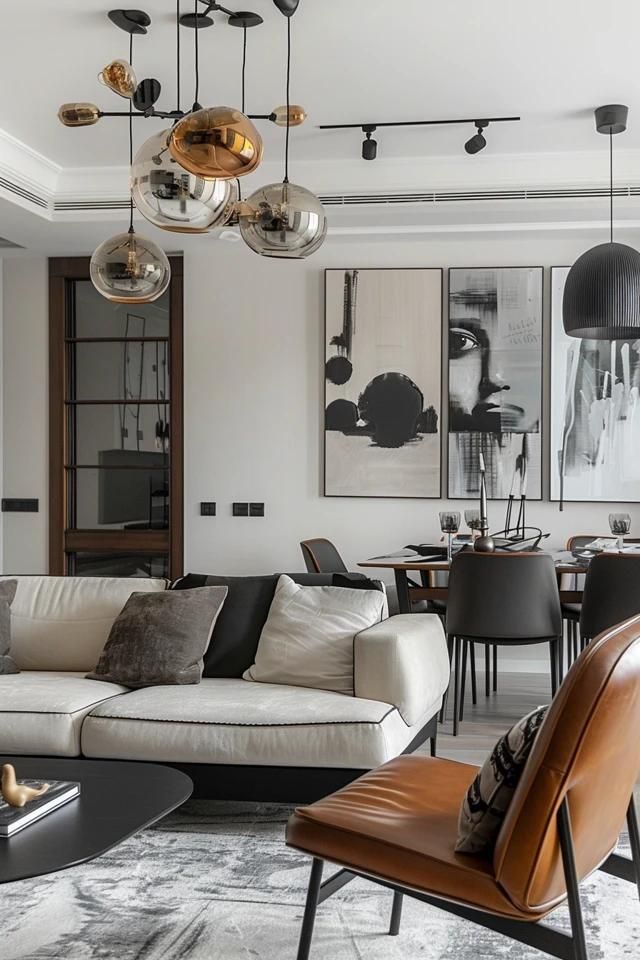
Core Principles of Minimalist Industrial Design
Minimalist industrial design thrives on the careful balance between form and function, stripping away excess to reveal the essential. The discipline combines raw industrial elements with clean aesthetics to create spaces and products that feel both authentic and purposeful.
Defining Minimalist Industrial Aesthetics
Minimalist industrial aesthetics embrace the philosophy that “less is more” by focusing on visual simplicity and clean design. You’ll notice a deliberate reduction of decorative elements, allowing the essential features to stand out. This approach highlights authentic materials like concrete, steel, and wood in their natural state.
Color palettes typically remain neutral and restrained – think whites, grays, blacks, and earth tones. These limited color schemes create a sense of cohesion and calm.
The power of negative space is paramount in minimalist industrial design. Empty areas aren’t viewed as wasted space but as intentional breathing room that enhances the impact of the few carefully selected elements present.
Balancing Functionality and Simplicity
Functionality stands as the cornerstone of minimalist industrial design. Every element must serve a clear purpose – decorative features that don’t contribute to function are eliminated. You should consider how each component enhances the user experience.
Products and spaces follow Dieter Rams’ principle that “good design is as little design as possible.” This doesn’t mean sacrificing functionality – quite the opposite. The challenge lies in creating solutions that do more with less.
Multi-purpose features are highly valued in this design approach. Furniture pieces that offer storage, adjustable lighting that serves different needs, or modular systems that adapt to changing requirements exemplify this principle.
The true art of minimalist industrial design emerges when simplicity enhances rather than limits functionality.
Minimalism Meets Industrial Elements
Industrial minimalism celebrates the raw beauty of structural elements. You’ll find exposed beams, ductwork, pipes, and brick walls serving as design features rather than elements to be concealed. These components tell the authentic story of a space or product.
Materials are selected for their durability, functionality, and aesthetic honesty. Metal, concrete, reclaimed wood, and glass are commonly featured for their industrial character and minimalist appeal.
The juxtaposition of refined minimalism with rugged industrial elements creates compelling visual tension. Smooth concrete surfaces might contrast with rough-hewn wooden beams, or delicate glass fixtures might stand against raw steel supports.
Scale plays a crucial role – large, statement pieces with clean lines often anchor spaces, allowing smaller functional elements to complement rather than compete with them.
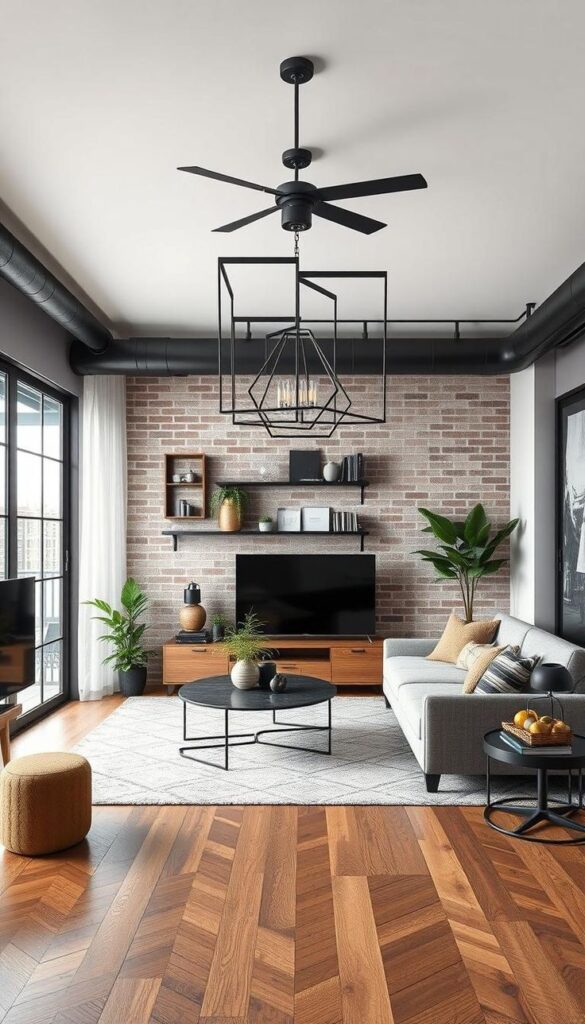
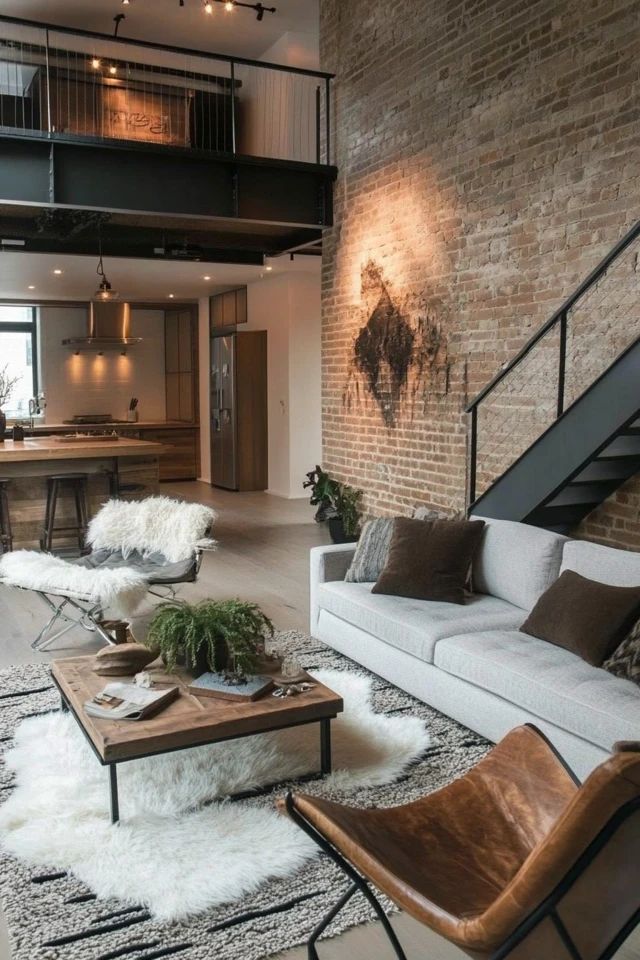
Key Materials and Textures in Minimalist Industrial Design
Minimalist industrial design relies on a carefully curated selection of raw, authentic materials that showcase both form and function. These materials create visual interest through their natural characteristics rather than excessive decoration or ornamentation.
Exposed Concrete and Raw Finishes
Concrete serves as the foundation of minimalist industrial design, prized for its durability and versatility. You’ll find it used in floors, walls, countertops, and even custom furniture pieces. The beauty of concrete lies in its imperfections—subtle variations in color, small air bubbles, and visible aggregate create visual depth.
Raw concrete finishes can be customized through different techniques:
- Polished: Smooth, reflective surface
- Stamped: Textured patterns
- Acid-stained: Variegated color effects
- Board-formed: Wood grain impressions
For maintenance, concrete surfaces typically require sealing to prevent staining and moisture absorption. When properly treated, concrete develops a natural patina over time that adds character to your space.
Steel, Metals, and Metal Accents
Metal elements provide structural integrity and visual contrast in minimalist industrial spaces. Steel beams, columns, and brackets often remain exposed, celebrating the architectural framework rather than concealing it.
Common metal applications:
- Blackened steel staircases and railings
- Brass or copper fixtures and hardware
- Weathered metal wall panels
- Perforated metal room dividers
- Brushed nickel or chrome details
Metal finishes range from raw and rusted to polished and pristine. You can incorporate metal accents through lighting fixtures, furniture frames, and decorative objects. These elements add visual weight and industrial authenticity to your design.
The durability of metals makes them practical choices for high-traffic areas and frequently used items.
Wood and Reclaimed Surfaces
Wood brings warmth and organic texture to minimalist industrial interiors, softening the harder elements of concrete and metal. Reclaimed wood offers environmental benefits while providing unique character through visible history and patina.
Look for wooden elements with these characteristics:
- Visible grain patterns
- Knots and natural imperfections
- Weathered or distressed finishes
- Minimal treatment (often just sealed, not painted)
Reclaimed wooden beams, factory flooring, and barn wood can be repurposed for flooring, wall treatments, and statement furniture pieces. The contrast between smooth, polished metals and rough-hewn wood creates visual tension that defines minimalist industrial spaces.
You can maintain the natural beauty of wood by using matte finishes that protect without obscuring the material’s inherent qualities.
Glass, Aluminum, and Plastics
These modern materials complement traditional industrial elements by adding lightness, transparency, and contemporary touches. Large windows with black metal frames allow natural light to flood spaces while maintaining industrial aesthetics.
Effective applications include:
- Floor-to-ceiling windows or glass walls
- Glass-topped tables with metal bases
- Aluminum shelving systems
- Industrial-grade plastic seating
When selecting plastics, focus on high-quality, durable options that resist yellowing and degradation. Modern manufacturing techniques have created plastics that mimic natural materials while offering superior performance characteristics.
Aluminum provides lightweight strength for shelving, cabinet frames, and decorative accents. Its clean, precise lines complement the more rugged textures of concrete and reclaimed wood.
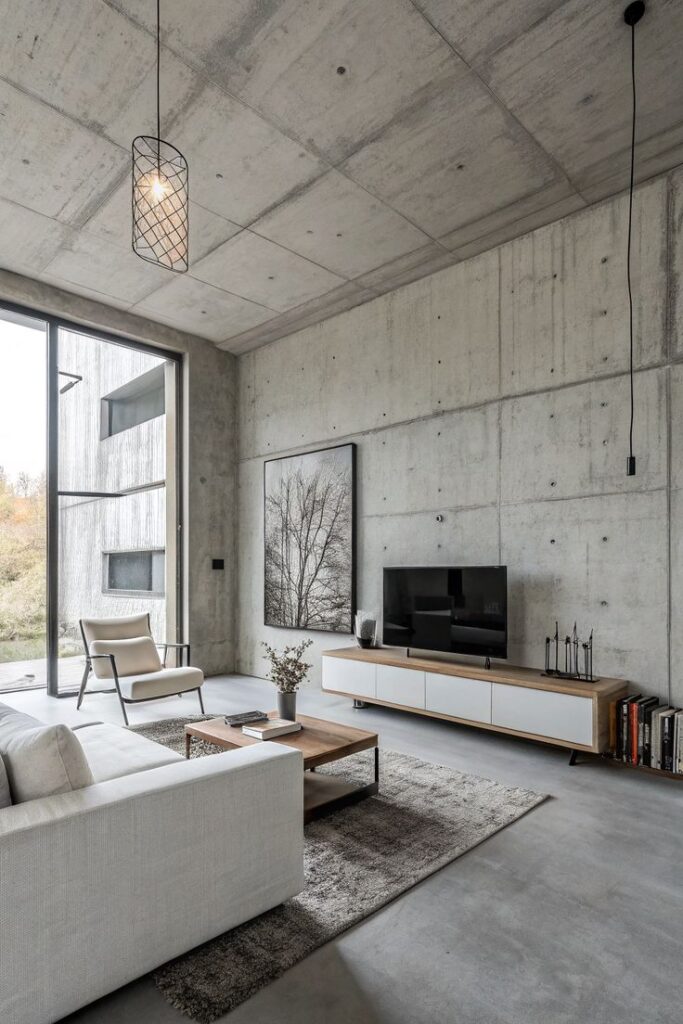
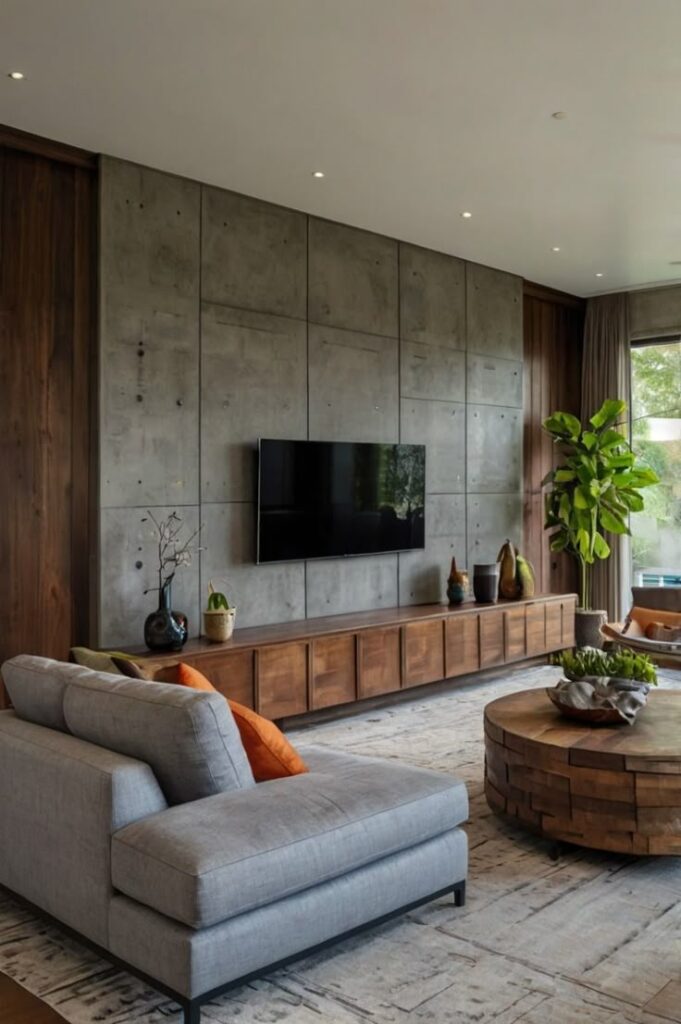
Architectural Features and Structural Elements
The foundation of minimalist industrial design lies in its distinctive architectural elements that blend raw functionality with deliberate simplicity. These structural components not only define the aesthetic but also serve as fundamental design features that create authentic industrial spaces.
Exposed Brick and Industrial Walls
Exposed brick walls serve as the quintessential backdrop in minimalist industrial spaces. These unfinished surfaces add warmth, texture, and character while connecting to the design’s industrial roots. You’ll find that leaving brick in its natural state creates an authentic focal point that requires minimal additional decoration.
For spaces without natural brick, consider brick veneers or textured wall treatments that mimic industrial materials. Concrete walls provide an alternative with their cool, monolithic appearance that embodies industrial minimalism’s raw aesthetic.
Wall treatments in this style typically remain unadorned, allowing the natural beauty of materials to speak for themselves. When painting is necessary, neutral tones like whites, grays, and blacks maintain the understated industrial palette while highlighting architectural features.
Open Floor Plans and Clean Lines
Open floor plans define minimalist industrial spaces, removing unnecessary walls to create flowing, functional areas. This spatial openness reflects the design’s origins in converted factories and warehouses where large, uninterrupted spaces were the norm.
You’ll benefit from the versatility these layouts provide, allowing you to define zones through furniture placement rather than physical barriers. Clean lines in both architecture and furnishings reinforce the minimalist aspect of the style.
Strategic placement of dividers like bookcases, area rugs, or metal screens can help define separate functional areas while maintaining the open aesthetic. The uncluttered approach emphasizes functionality and creates a sense of expansiveness even in smaller spaces.
Ceilings, Floors, and Ductwork
Raw ceilings with exposed pipes, ductwork, and steel beams create authentic industrial character overhead. Instead of hiding these elements, minimalist industrial design celebrates them as visual features that add depth and interest.
For flooring, concrete provides the ideal foundation with its durability and industrial appearance. You can soften concrete floors with area rugs while maintaining the industrial vibe. Other appropriate options include reclaimed wood planks, which add warmth, or polished cement for a more refined look.
Bare windows with minimal treatments allow maximum natural light while showcasing industrial-style frames. Metal frames in black or dark finishes complement the overall aesthetic. Consider factory-style windows with multiple panes for authentic industrial character that makes a dramatic architectural statement.
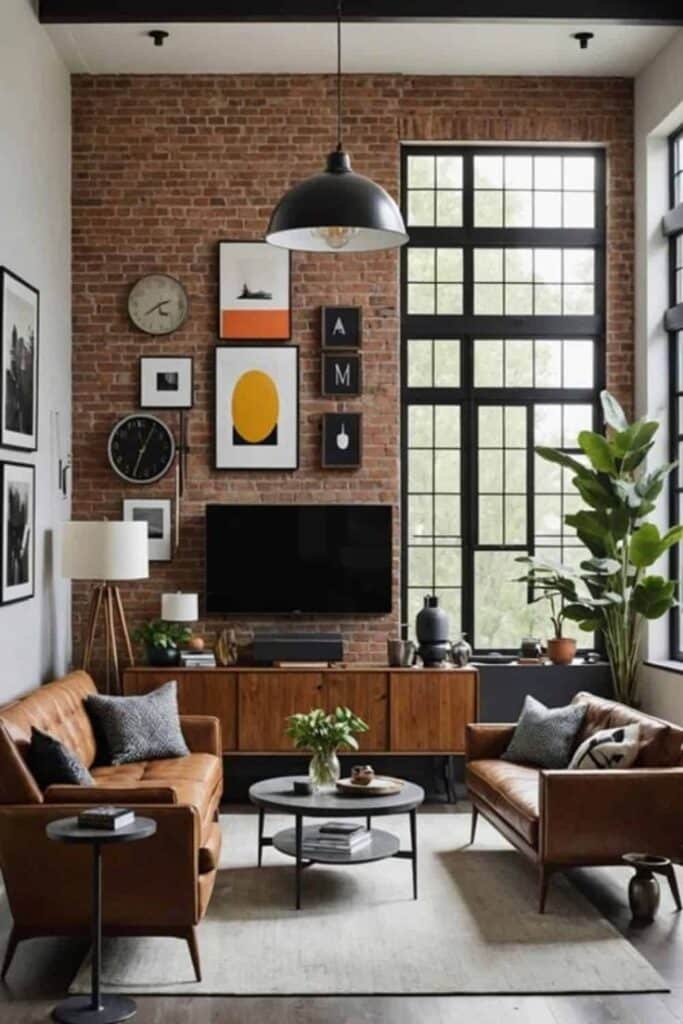
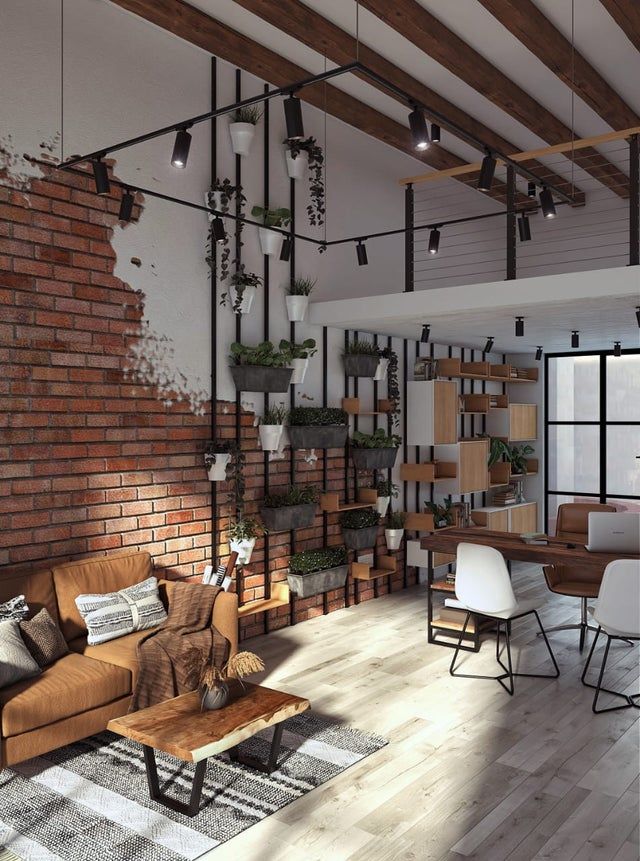
Color Palettes, Light, and Ambiance
The foundation of minimalist industrial design lies in its thoughtful approach to color selection and lighting strategies that highlight architectural elements while creating inviting spaces.
Neutral Tones and Stark White Walls
Neutral colors form the backbone of minimalist industrial design, creating a clean canvas that emphasizes form and function. Shades of grey—from light silver to deep charcoal—offer sophisticated versatility while maintaining an urban edge.
Stark white walls serve as the perfect backdrop for industrial elements, reflecting light and making spaces feel larger. This deliberate absence of color draws attention to textural elements like exposed brick or concrete.
Consider these core neutrals for your palette:
- Concrete grey – Echoes industrial materials
- Charcoal – Adds depth and grounding
- Warm beige – Softens harder elements
- Crisp white – Creates breathing space
Black accents in window frames, fixtures, or furniture provide definition without overwhelming the space. Earth tones like rust, terracotta, or muted olive can introduce subtle warmth while maintaining minimalist discipline.
Natural and Ambient Lighting
Natural light transforms industrial spaces, softening hard edges and highlighting textural details. Position furniture to maximize daylight penetration, keeping window treatments minimal or absent.
Skylights offer dramatic lighting effects while honoring industrial architecture. For spaces with limited windows, strategically placed mirrors can amplify available natural light.
After dark, layered lighting creates depth and dimension:
- Task lighting – Focused illumination for functional areas
- Accent lighting – Highlights architectural features
- Ambient lighting – Provides overall illumination
Edison bulbs with exposed filaments add authentic industrial character while creating warm ambient glow. Pendant lights with metal shades reference factory aesthetics while directing light precisely where needed.
Consider dimmers for flexible lighting control that transitions from energizing daytime brightness to evening ambiance. Light temperature matters—opt for warmer tones (2700-3000K) to balance industrial coolness.
Accents and Contrast in Minimalist Space
Strategic color accents prevent minimalist industrial spaces from feeling cold or austere. Limit bold colors to 10-20% of your overall scheme through accessories, artwork, or a single statement piece.
Materials create contrast through their inherent properties:
- Metal finishes – Brass, copper, or blackened steel add warmth
- Wood elements – Introduce organic texture
- Leather details – Age beautifully with natural patina
Textiles offer opportunities for subtle contrast through texture rather than color. Consider:
- Rough linen
- Nubby wool
- Raw canvas
- Distressed leather
Plants introduce living color that complements industrial minimalism without disrupting the aesthetic. Choose architectural varieties like fiddle leaf figs or snake plants with strong silhouettes.
Remember that negative space is essential—allow for visual breathing room between elements to maintain minimalist principles while showcasing carefully selected industrial pieces.
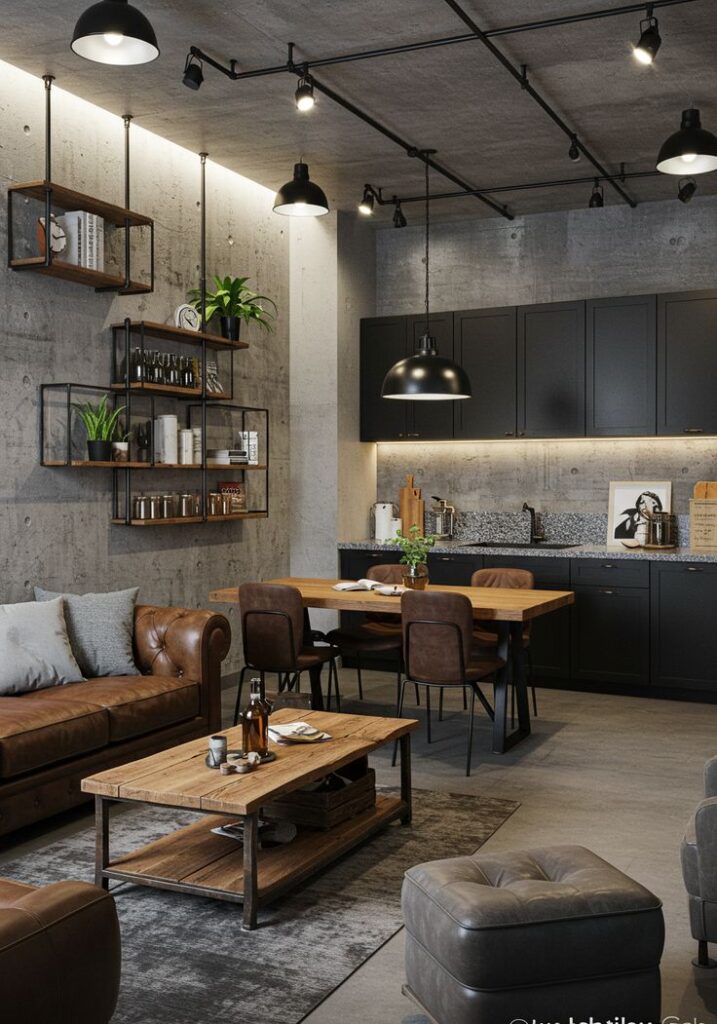
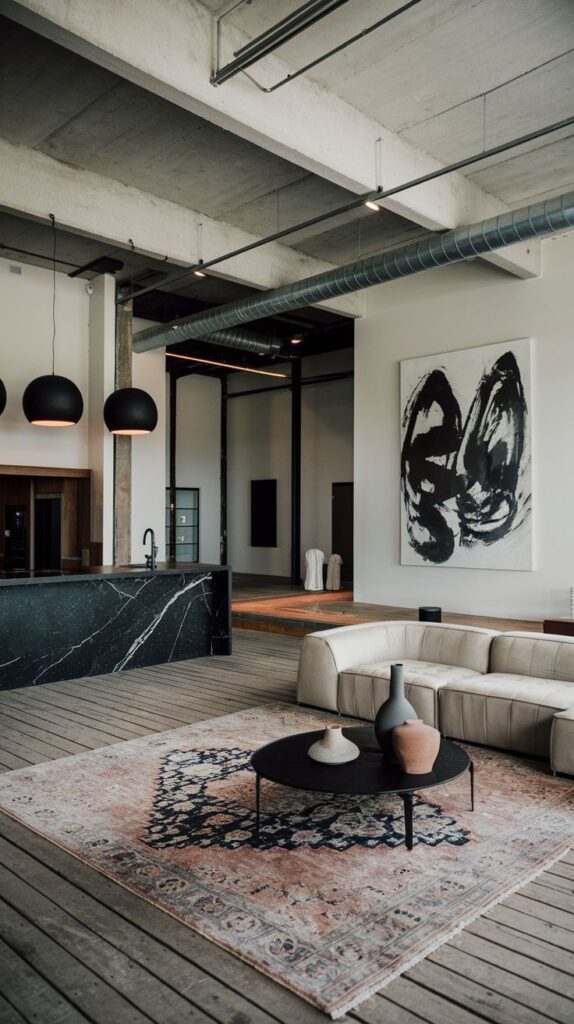
Furnishings, Accessories, and Sustainable Choices
Selecting the right elements for your minimalist industrial space requires thoughtful consideration of both form and function. The furnishings and accessories you choose will define the character of your space while maintaining the essential balance between raw industrial elements and minimalist simplicity.
Minimalist Furniture and Integrated Storage
Furniture in industrial minimalist spaces should serve dual purposes of functionality and aesthetic appeal. Choose pieces with clean lines and simple forms made from materials like metal, reclaimed wood, and concrete that complement the industrial aesthetic.
Invest in multi-functional furniture that incorporates storage solutions. A bed with built-in drawers or a coffee table with shelving underneath helps maintain clutter-free surfaces essential to minimalist design.
Consider the scale of your furniture carefully. Oversized pieces can overwhelm a space while too-small items may look insignificant against industrial backdrops. Look for furniture with exposed metal frames, wheels, or mechanical elements that reference industrial heritage.
Integrated storage is crucial for maintaining minimalism. Built-in shelving, wall-mounted cabinets, and furniture with hidden compartments help keep necessities accessible but out of sight.
Accessories and Industrial Details
In minimalist industrial spaces, accessories should be purposeful and sparse. Select a few statement pieces rather than numerous small decorations that can create visual clutter.
Vintage industrial objects make excellent focal points—consider repurposed factory lighting, old manufacturing gauges, or authentic industrial signage. These pieces add character while honoring the industrial aesthetic’s heritage.
Textiles offer opportunities to soften the hard edges of industrial spaces. Choose simple, high-quality fabrics in neutral tones or muted colors for cushions, throws, and rugs.
Metal details like exposed hardware, steel brackets, or copper accents can enhance the industrial feel while maintaining minimalist principles. Remember that in minimalist design, even small accessories should serve a purpose beyond mere decoration.
Adding Greenery for Contrast
Plants provide vital organic contrast to the hard surfaces and straight lines dominant in industrial minimalist spaces. The juxtaposition of living greenery against concrete, metal, and wood creates visual interest and balance.
Select low-maintenance varieties that complement your aesthetic—spider plants, snake plants, and succulents thrive with minimal care while adding texture and life. For dramatic effect, consider larger specimens like fiddle leaf figs or rubber plants as statement pieces.
Display plants in simple containers that enhance rather than compete with your decor. Concrete planters, metal buckets, or simple ceramic pots in neutral colors work well within the industrial minimalist palette.
Strategic placement of greenery can soften architectural features or highlight design elements. A trailing plant atop a bookshelf or a tall specimen beside exposed brick creates natural focal points.
Sustainability in Minimalist Industrial Design
Sustainability aligns naturally with minimalist industrial design principles. The style’s emphasis on repurposing materials reflects a rejection of disposable consumerism that defined the original industrial revolution.
Source furniture made from reclaimed materials or produced by manufacturers with transparent, eco-friendly practices. Look for pieces constructed from sustainably harvested wood, recycled metals, or innovative eco-materials.
Embrace the “less is more” philosophy by investing in fewer, higher-quality pieces that will last decades rather than seasons. This approach reduces waste and environmental impact while creating a more authentic space.
Consider energy efficiency in your lighting choices. LED bulbs in vintage-style fixtures offer industrial appeal with modern environmental benefits. When selecting textiles, opt for natural fibers like organic cotton, linen, or hemp that have lower environmental impacts.
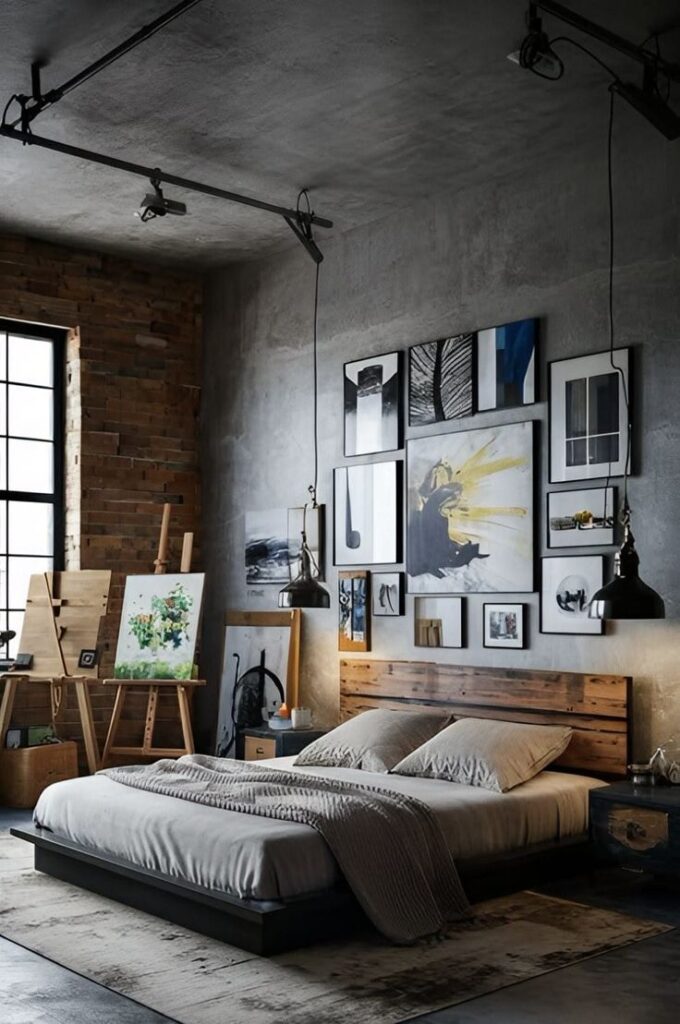
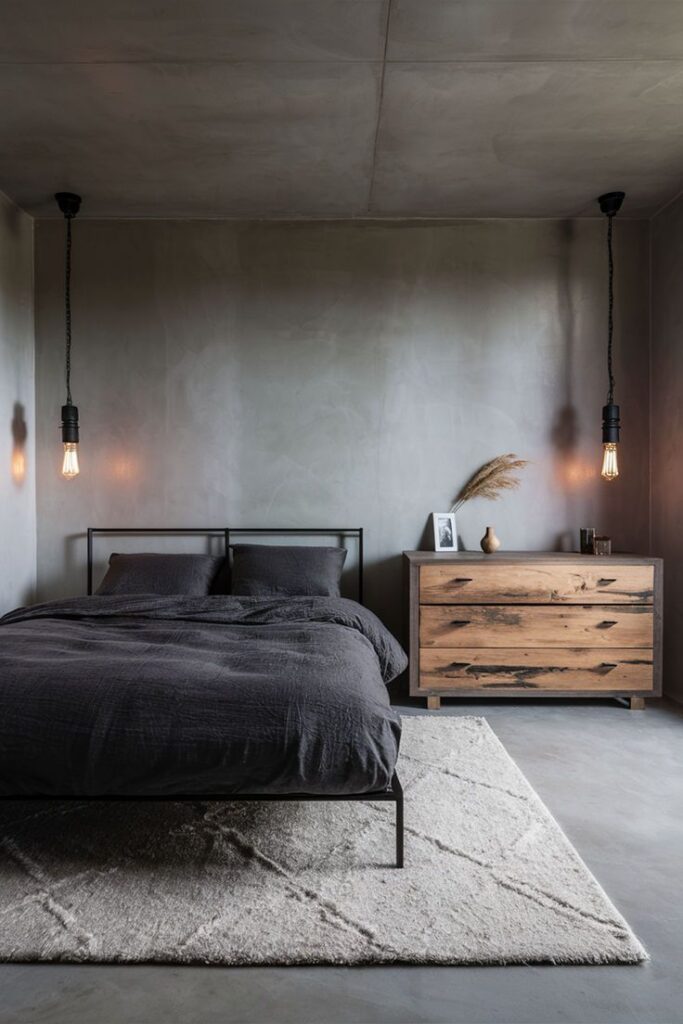
Applications and Modern Interpretations
Minimalist industrial design has evolved from its factory-floor origins to become a versatile style applied across various spaces. Its adaptability stems from the balance of utilitarian elements with clean, purposeful aesthetics.
House Design and Residential Spaces
In residential applications, minimalist industrial design creates spaces that feel both raw and refined. Exposed brick walls, concrete floors, and visible ductwork serve as foundational elements that add character without overwhelming the space.
Open floor plans dominate these homes, allowing natural light to flow through large factory-style windows. You’ll often find metal-framed furniture with simple lines complemented by natural materials like reclaimed wood.
Subway tiles have become a signature element in industrial kitchens and bathrooms, offering clean lines while nodding to urban infrastructure. These spaces typically feature a restrained color palette – predominantly whites, blacks, and grays – with occasional pops of color through accessories.
Storage solutions in minimalist industrial homes emphasize functionality, often using open shelving or repurposed industrial containers. The beauty lies in honesty of materials and purpose rather than decorative embellishments.
Commercial and Office Environments
Commercial spaces have embraced minimalist industrial design for its ability to create productive, authentic environments. Tech startups and creative agencies particularly favor this aesthetic for its innovative yet unpretentious feel.
Open ceilings revealing structural elements and mechanical systems have become standard, eliminating the need for drop ceilings while creating a sense of spaciousness. Polished concrete floors provide durability while maintaining the industrial aesthetic.
You’ll notice modular furniture systems that adapt to changing workplace needs, often featuring metal frames with simple wooden surfaces. Lighting typically includes exposed bulbs, factory pendants, or track systems that highlight architectural elements.
Communal areas often incorporate standing-height tables with metal stools, creating casual collaboration spaces. The overall effect balances professionalism with creativity, avoiding corporate sterility.
Blending Rustic Charm with Sleek Appearance
The most successful minimalist industrial spaces achieve harmony between rustic elements and sleek contemporary lines. This balance prevents spaces from feeling either too cold or overly nostalgic.
You can incorporate rustic charm through weathered wood beams, vintage factory fixtures, or distressed leather seating. These elements add warmth and history to the space without compromising the clean aesthetic.
Sleek counterpoints might include frameless glass partitions, polished metal surfaces, or streamlined cabinetry with hidden hardware. Modern technology should integrate seamlessly, avoiding visual clutter.
Lighting plays a crucial role in this balance – industrial-inspired fixtures with contemporary LED technology offer both aesthetic appeal and functionality. Consider adjustable systems that allow you to highlight different elements depending on time of day or purpose.
This blended approach creates spaces that feel simultaneously timeless and contemporary, avoiding the pitfalls of strict adherence to a single design philosophy.
- 27shares
- Facebook0
- Pinterest27
- Twitter0
- Reddit0








